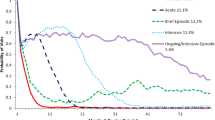Abstract
The Fort Bragg Evaluation Project hypothesized that the mental health of children treated in the Demonstration’s continuum of care would improve more than that of children receiving traditional mental health services at a comparison site. Program theory further predicted site differences in outcome for certain subgroups of children, such as those with severe mental health problems. These hypotheses were tested at 6-month and 1-year follow-ups in several ways, but results showed only slightly more site differences than expected by chance. For the evaluation sample ofN=984 treated children aged 5–17, site differences favored the Comparison about as often as the Demonstration. Children at both sites improved, but there was no overall superiority in mental health outcomes at the Demonstration.
Similar content being viewed by others
References
Behar L, Bickman L, Lane T, et al.: Fort Bragg child and adolescent mental health demonstration project. In: Roberts N (Ed.):Model Practices in Service Delivery in Child and Family Mental Health. Hillsdale, NJ: Lawrence Erlbaum in press.
Achenbach TM:Manual for the Child Behavior Checklist and 1991 Profile. Burlington, VT: University of Vermont, Department of Psychiatry, 1991.
Lipsey MW, Wilson DB: The efficacy of psychological, educational, and behavioral treatment: Confirmation from meta-analysis.American Psychologist 1993; 48:1181–1209.
Achenbach TM, Edelbrock C:Manual for the Youth Self-Report and Profile. Burlington, VT: University of Vermont, Department of Psychiatry, 1987.
Herjanic B, Herjanic M, Brown F, et al.: Are children reliable reporters?Journal of Abnormal Child Psychology 1987; 3(1):41–48.
Herjanic B, Reich W: Development of a structured psychiatric interview for children: Agreement between child and parent on individual symptoms.Journal of Abnormal Child Psychology 1982; 10(3):307–324.
Kazdin AE, Esveldt-Dawson K, Unis A, et al.: Child and parent evaluations of depression and agression in psychiatric inpatient children.Journal of Abnormal Child Psychology 1983; 11(3):401–413.
Treiber FA, Mabe PA: Child and parent perceptions of children’s psychopathology in psychiatric outpatient children.Journal of Abnormal Child Psychology 1987; 15(1):115–124.
Hodges K, Cools J: Structured diagnostic interviews. In: LaGreca AM (Ed.):Through the Eyes of the Child: Obtaining Self-Report from Children and Adolescents. Boston: Alloyn & Bacon, 1990, pp. 109–149.
Hodges K, Kline J, Stern L, et al.: The development of a child assessment interview for research and clinical use.Journal of Abnormal Child Psychology 1982; 10:173–189.
Jacobson NS, Truax P: Clinical significance: A statistical approach to defining meaningful change in psychopathology research.Journal of Consulting and Clinical Psychology 1991; 59(1):12–19.
Cronbach LJ, Furby L: How should we measure change—Or should we?Psychological Bulletin 1970; 74:68–80.
Newman SJ, Reschovsky JD, Koneda K, et al.: The effects of independent living on persons with chronic mental illness: An assessment of the Section 8 Certificate Program.Milbank Quarterly 1994; 72(1):171–190.
Maxwell SE, Delaney HD: Bivariate median splits and spurious statistical significance.Psychological Bulletin 1993; 113(1):181–190.
Guthrie D: Analysis of dichotomous variances in repeated measures experiments.Psychological Bulletin 1981; 90:189–195.
Bickman L, Guthrie P, Foster M, et al.:Managed Care in Mental Health: The Fort Bragg Experiment. New York: Plenum, in press.
SAS Institute, Inc.:SAS Technical Report P-229, SAS/STAT Software Changes and Enhancements, Release 6.07. Cary, NC: SAS Institute, 1992.
Bryk AS, Raudenbush SW, Congdon RT:HLM23, Hierarchical Linear Modeling with the HLM/2L and HLM/3L Programs. Chicago: Scientific Software International, 1994.
Dar R, Serlin DC, Omer H: Misuse of statistical tests in three decades of psychotherapy research.Journal of Consulting and Clinical Psychology 1994; 62(1):75–82.
Author information
Authors and Affiliations
Corresponding author
Additional information
This research was supported by the U.S. Army Health Services Command (DADA 10-89-C-0013) as a subcontract from the North Carolina Department of Human Resources, Division of Mental Health, Developmental Disabilities, and Substance Abuse Services, and a grant to Dr. Leonard Bickman (R01MH-46136-01) from the National Institute of Mental Health. This article is part of a special issue that focuses on the Fort Bragg Evaluation. These articles are best understood when read together. The articles are cross-referenced where most appropriate.
Rights and permissions
About this article
Cite this article
Lambert, E.W., Guthrie, P.R. Clinical outcomes of a children’s mental health managed care demonstration. The Journal of Mental Health Administration 23, 51–68 (1996). https://doi.org/10.1007/BF02518643
Issue Date:
DOI: https://doi.org/10.1007/BF02518643




